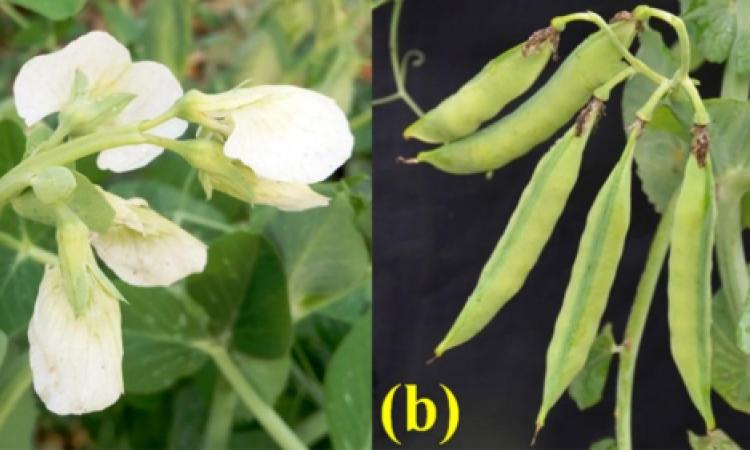
भारतीय भोजन में प्रमुख रूप से शामिल मटर प्रोटीन का एक प्रमुख स्रोत है और दलहन तथा सब्जी के रूप में इसका उपयोग बहुतायत में होता है। भारतीय शोधकर्ताओं ने अब मटर के पौधे में अधिक फूल लगने वाली प्रजाति विकसित की है, जिसके कारण पौधे पर पैदा होने वाली मटर की फलियों की संख्या बढ़ सकती है।
मटर की सामान्य किस्मों के पौधे में प्रति डंठल पर एक या दो फूल होते हैं। वैज्ञानिकों ने मटर की दो अलग-अलग प्रजातियों वीएल-8 और पीसी-531 के संकरण के जरिये मटर की नई किस्म तैयार की है। वैज्ञानिकों के अनुसार, इस नई प्रजाति के प्रत्येक डंठल पर शुरू में दो फूल लगते हैं, लेकिन चार पीढ़ी के बाद इस प्रजाति के पौधों के प्रत्येक डंठल में दो से अधिक फूल देखे गए हैं, जिससे एक डंठल में अधिक फलियाँ लगती हैं।
संकरण से प्राप्त पाँच किस्मों वीआरपीएम-501, वीआरपीएम-502, वीआरपीएम-503, वीआरपीएम-901-3 और वीआरपीएसईएल-1पी के पौधों के कई डंठलों में तीन फूल भी उत्पन्न हुए हैं। एक अन्य प्रजाति, जिसे वीआरपीएम-901-5 नाम दिया गया है, के डंठलों में पाँच फूल तक देखे गए हैं। मटर की इन प्रजातियों के पौधों के आधे से अधिक डंठलों में दो से अधिक फूल लगे पाये गए हैं।
भारतीय सब्जी अनुसंधान संस्थान (आईवीआरआई), वाराणसी, भारतीय कृषि अनुसंधान संस्थान, नई दिल्ली और केंद्रीय मृदा लवणता अनुसंधान संस्थान, करनाल के वैज्ञानिकों द्वारा यह अध्ययन किया गया है। अध्ययन के नतीजे शोध पत्रिका पलास वन में प्रकाशित किए गए हैं।
शोधकर्ताओं में शामिल आईवीआरआई से जुड़े वैज्ञानिक डॉ. राकेश के. दुबे ने इंडिया साइंस वायर को बताया कि “एक डंठल पर अधिक पुष्पण वाली नई किस्मों के मटर के पौधों के उत्पादन में सामान्य किस्मों की अपेक्षा उल्लेखनीय बढ़ोत्तरी देखी गई है।”
दुबे के अनुसार, "इस शोध के नतीजों से शोधकर्ताओं, शिक्षाविदों और उद्योगों को एक आधार मिलेगा, जिससे मटर की बेहतर गुणवत्ता एवं अधिक उत्पादन वाली प्रजातियाँ विकसित करने में मदद मिल सकती है। एक डंठल में अधिक फलियों के उत्पादन के साथ-साथ जल्दी पैदावार देने वाली किस्मों के विकास संबंधी शोध भविष्य में किए जा सकते हैं।”
वैज्ञानिकों का कहना यह भी है कि बहु-पुष्पण या अधिक फूल आने के बावजूद कई बार डंठल में अधिक फलियाँ पैदा नहीं हो पाती हैं। वीआरपीएसईएल-1पी एक ऐसी ही नई प्रजाति है, जिसमें बहु-पुष्पण को मोटी डंठल का सहारा नहीं मिल पाता है। इस वजह से फूल अथवा फलियाँ समय से पहले नष्ट हो जाती हैं और पौधे की उत्पादन क्षमता का भरपूर लाभ नहीं मिल पाता। शोधकर्ताओं ने यह भी पाया है कि बहु-पुष्पण वाले कई पौधे मध्य से देर तक परिपक्व होते हैं और इन पौधों के पुष्पण की स्थिति में अधिक तापमान का महत्त्वपूर्ण प्रभाव पड़ता है।
शोधकर्ताओं में डॉ. दुबे के अलावा ज्योति देवी, प्रभाकर एम. सिंह, बिजेंद्र एम. सिंह, ज्ञान पी. मिश्रा और सतीश के सांवल शामिल थे।
भाषांतरण : उमाशंकर मिश्र
Scientists develop promising multi-flowering pea varieties
Dr. Aditi Jain
New Delhi, August 21 (India Science Wire): Legumes, a source of high protein, holds a special place in Indian diets. Among legumes, peas which are rich in vitamins and proteins are cherished for its taste and are a part of various cuisines.
Now scientists from the Indian Council of Agricultural Research have developed a pea variety that bears more flowers per stalk and therefore yields more peas per plant.
Naturally occurring pea varieties have one or two flowers per stalk. Researchers crossed two pea varieties - VL-8 and PC-531 - which bear two flowers per peduncle but found that after the fourth generation many of the derived plants had more than two flowers and yielded more than two pods in many of their stalks.
Five varieties derived from the cross (VRPM-501, VRPM–502, VRPM–503, VRPM–901–3 and VRPSeL–1 p) yielded three flowers on many of the stalks whereas a variety, now named VRPM–901–5 yielded up to five flowers in many of its stalk. Over half the stalks showed more than two flowers.
Newly synthesized variety of pea VRPM 901- 5 has five flowers and consequently five pods per stalk rather than two “Preliminary observations do indicate significant yield advantage in the multi-flowering genotypes identified in this study over single and double-flowering genotypes,” said Dr. Rakesh K Dubey, a member of the research team from the ICAR-Indian Institute of Vegetable Research, while talking to India Science Wire.
“The future line of work envisages evolving varieties that would possess the characteristic of earliness along with multi-pods per stalk. Present findings would set a platform for researchers, academicians, and industries to generate improved varieties in vegetable pea both in terms of quantity and quality,” Dubey said.
Scientists also found that multiple flowering did not always corresponded to more pod yield as in certain derived variety (VRPSeL–1 p) multiple flowering was not supported by the thick stalk. Due to this flower or pod got shattered in an untimely manner restricting the realized potential. They also observed that multiple flowering plants were always mid to late maturing and temperature had a significant effect on multiple flowering status of the plant.
The study has been published in journal PLOS One. The research team included Jyoti Devi, Rakesh K. Dubey, Prabhakar M. Singh and Bijendra Singh (Indian Institute of Vegetable Research, Varanasi); Gyan P. Mishra (Indian Agricultural Research Institute, New Delhi); and Satish K. Sanwal (Central Soil Salinity Research Institute, Karnal. (India Science Wire)
Twitter handle: @AditiJain1987
|
TAGS |
|
Pea in hindi, ICAR in hindi, multi-flowering in hindi, protein content in hindi |
/articles/matara-kai-adhaika-pausapana-vaalai-parajaataiyaan-vaikasaita